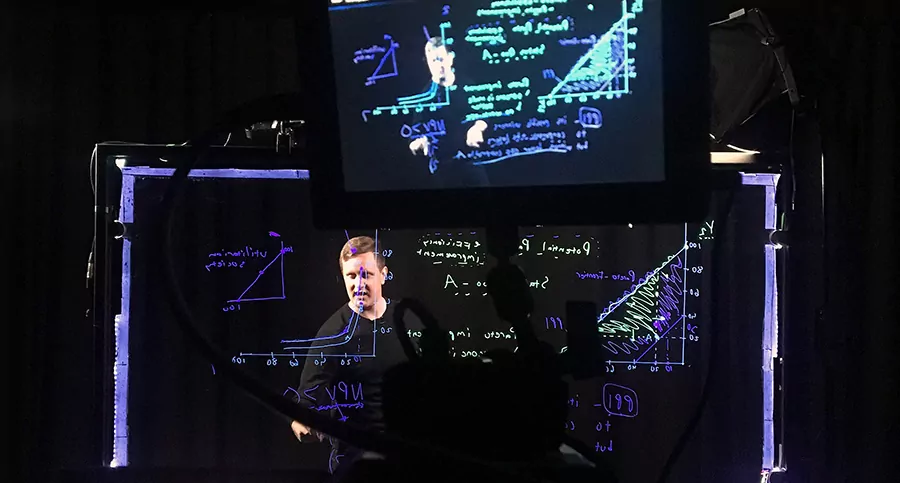Chemical formulas, mathematical diagrams, and large data sets can be hard to grasp by merely listening or reading. The lightboard is revolutionising teaching video production by making even the most complex online lectures easy and cost-effective to illustrate.
“Producing a teaching video is an entirely different matter from giving a lecture,” say Lauri Manninen and Heikki Jantunen, who are responsible for Unigrafia’s Creative Studio video productions. “Even if a teacher feels completely at home in a lecture hall, they might freeze in front of the camera. Filming can be nerve-wracking because it’s unfamiliar – and on top of talking to a camera, you need to condense your message into just a fraction of the time of a regular lecture.”
That’s why the filming process at Unigrafia is designed to be as easy and relaxed as possible. When a client arrives at the studio, they don’t need any technical knowledge or understanding of video production. It’s enough that they know their subject – the production team takes care of everything else. “Our job is to help everyone feel at ease in front of the camera,” says Jantunen with a smile. “We chat, offer coffee, and often step in front of the camera ourselves to demonstrate how it’s done,” Manninen adds. “We’ve found this really helps break the ice and lift the mood.”
The demand for new teaching methods has exploded in recent years. Instead of traditional lecture recordings or ‘talking heads’, people now want dynamic animations, visualised data, and rich infographics.
“But budgets often don’t stretch that far,” Jantunen points out. The lightboard offers a solution – it’s affordable and visually engaging. “So far, we’ve used the lightboard installed at Aalto University earlier this year, but because demand has grown so quickly, we’ve decided to install one at Unigrafia too. Word about the acquisition started spreading in the spring, and over the summer we received several enquiries. Now, the lightboard is finally on its way to the studio!”
Formulas, diagrams, and visualised data – how does a lightboard work?
The principle is simple: a non-reflective glass surface is written on with fluorescent markers. LED lights embedded around the glass edges illuminate the writing. Despite the new tech, the teaching situation is familiar – only the tools have changed. The chalk is replaced by a fluorescent pen, and the blackboard by a glass sheet. The lecturer looks directly into the camera through the glass, keeping eye contact with the audience. The biggest advantage over traditional blackboards or overheads is that students can see the lecturer’s facial expressions and gestures the entire time – even while they write or draw on the “board”.
The lightboard is especially well suited for science and economics subjects that rely heavily on equations, diagrams, and data. Teaching becomes easier to follow and understand as the content builds up visually throughout the lecture. Drawing diagrams, highlighting key points, and visualising structure on the board helps students make sense of even difficult material. Digital elements such as PowerPoint slides or Excel tables can also be added in post-production.
“The content unfolds in front of students step by step – it’s actually kind of magical!” Jantunen enthuses. “When we filmed a series of economics lectures, even I, as a complete outsider, could follow what the diagrams were illustrating,” Manninen agrees. “A lightboard video is almost like an animation – but much simpler and more affordable to produce.”
Interested? Contact Unigrafia’s customer service to request a quote!
